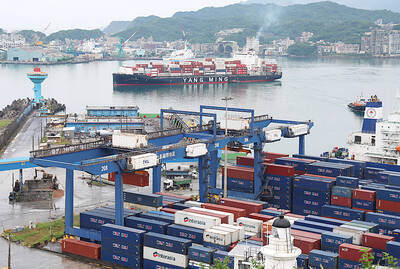China’s imports contracted sharply last month, while exports rose at a slower pace, reinforcing signs of feeble domestic demand despite the lifting of COVID-19 curbs and heaping pressure on an economy already struggling in the face of cooling global growth.
China’s economy grew faster than expected in the first quarter of this year thanks to robust services consumption, but factory output has lagged and the latest trade numbers point to a long road to regaining pre-COVID-19 momentum.
Inbound shipments to the world’s second-largest economy fell 7.9 percent year-on-year, extending the 1.4 percent decline seen a month earlier, while exports grew 8.5 percent, easing from the 14.8 percent surge in March, customs data showed yesterday.

Photo: AP
Economists in a Reuters poll had predicted no growth in imports and an 8 percent increase in exports.
“Given the gloomy outlook for external demand, we think exports will decline further before bottoming out later this year,” Capital Economics Ltd economist Zichun Huang (黃子春) said in a note.
“We still think reopening rebound in domestic demand will drive a recovery in imports over the coming months,” she added.
The downturn in imports suggests that the global economy is unlikely to be able to count much on China’s domestic engine of growth, and as the nation re-exports some of its imports, it also reinforces the extent of weakness in some of its major trading partner economies.
Analysts say the sharp global monetary policy tightening campaign of the past 12 to 18 months and recent Western banking stress remain concerns for the revival prospects of China and the world.
Shipment growth to ASEAN, China’s largest export partner, slowed to 4.5 percent last month from 35.4 percent in March.
Other data showed that South Korean exports to China, a leading indicator of China’s imports, were down 26.5 percent last month, continuing 10 consecutive months of decline.
China’s coal imports fell last month from a 15-month high the prior month, while imports of copper — a proxy for global growth — and natural gas were also down in the same period.
“The contraction of imports may be partly driven by the slowdown of global demand, which in turn affects China’s imports of parts and components for the processing of exports,” Pinpoint Asset Management Ltd (保銀私募基金管理) chief economist Zhiwei Zhang (張智威) said.
The official manufacturing purchasing managers’ index for last month showed new export orders contracting sharply, underlining the challenge facing Chinese policymakers and businesses hoping for a robust post-COVID-19 economic recovery.

CHIP RACE: Three years of overbroad export controls drove foreign competitors to pursue their own AI chips, and ‘cost US taxpayers billions of dollars,’ Nvidia said China has figured out the US strategy for allowing it to buy Nvidia Corp’s H200s and is rejecting the artificial intelligence (AI) chip in favor of domestically developed semiconductors, White House AI adviser David Sacks said, citing news reports. US President Donald Trump on Monday said that he would allow shipments of Nvidia’s H200 chips to China, part of an administration effort backed by Sacks to challenge Chinese tech champions such as Huawei Technologies Co (華為) by bringing US competition to their home market. On Friday, Sacks signaled that he was uncertain about whether that approach would work. “They’re rejecting our chips,” Sacks

Taiwan’s exports soared 56 percent year-on-year to an all-time high of US$64.05 billion last month, propelled by surging global demand for artificial intelligence (AI), high-performance computing and cloud service infrastructure, the Ministry of Finance said yesterday. Department of Statistics Director-General Beatrice Tsai (蔡美娜) called the figure an unexpected upside surprise, citing a wave of technology orders from overseas customers alongside the usual year-end shopping season for technology products. Growth is likely to remain strong this month, she said, projecting a 40 percent to 45 percent expansion on an annual basis. The outperformance could prompt the Directorate-General of Budget, Accounting and

NATIONAL SECURITY: Intel’s testing of ACM tools despite US government control ‘highlights egregious gaps in US technology protection policies,’ a former official said Chipmaker Intel Corp has tested chipmaking tools this year from a toolmaker with deep roots in China and two overseas units that were targeted by US sanctions, according to two sources with direct knowledge of the matter. Intel, which fended off calls for its CEO’s resignation from US President Donald Trump in August over his alleged ties to China, got the tools from ACM Research Inc, a Fremont, California-based producer of chipmaking equipment. Two of ACM’s units, based in Shanghai and South Korea, were among a number of firms barred last year from receiving US technology over claims they have

BARRIERS: Gudeng’s chairman said it was unlikely that the US could replicate Taiwan’s science parks in Arizona, given its strict immigration policies and cultural differences Gudeng Precision Industrial Co (家登), which supplies wafer pods to the world’s major semiconductor firms, yesterday said it is in no rush to set up production in the US due to high costs. The company supplies its customers through a warehouse in Arizona jointly operated by TSS Holdings Ltd (德鑫控股), a joint holding of Gudeng and 17 Taiwanese firms in the semiconductor supply chain, including specialty plastic compounds producer Nytex Composites Co (耐特) and automated material handling system supplier Symtek Automation Asia Co (迅得). While the company has long been exploring the feasibility of setting up production in the US to address